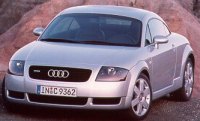 When
talking about exciting Audi, car magazines always recall the original
Quattro
(appeared in 1981). Oddly, for nearly two decades Audi failed to create
a worthy successor to the original Quattro - the S2 was intended to do
so but its lifeless steering, like other 4-wheel-drive Audis, drove
keen
drivers away to its rival in Munich. Later, the awesome RS2, with
Porsche's
hand in tuning, failed in the same way, although power and grip were
always
abundant. The most recent S4, though improved, is once again hardly
match
the Ur Quattro. Audi's fans felt frustrated enough, until the TT Coupe
comes. When
talking about exciting Audi, car magazines always recall the original
Quattro
(appeared in 1981). Oddly, for nearly two decades Audi failed to create
a worthy successor to the original Quattro - the S2 was intended to do
so but its lifeless steering, like other 4-wheel-drive Audis, drove
keen
drivers away to its rival in Munich. Later, the awesome RS2, with
Porsche's
hand in tuning, failed in the same way, although power and grip were
always
abundant. The most recent S4, though improved, is once again hardly
match
the Ur Quattro. Audi's fans felt frustrated enough, until the TT Coupe
comes.
The TT Coupe project started not very promising, mainly because it was said to share VW Golf IV's platform, which has been notorious in handling. Partly because it was said to use Volkwagen's part-time Syncro 4WD system. Luckily, Audi did not receive all the things without alteration. It realised that the Golf's half-independent torsion beam rear suspension is the choice for cheap and space-efficient hatchback. No matter how hard they work, it would never achieve the high level of camber control that a sports car ask for. Therefore they developed a new multi-link suspension, mounted it on a subframe before attaching to the chassis in order to reduce NVH further. Then, it turned down the adoption of Syncro system for the benefit of handling. Since the Quattro system is deemed to be too large and heavy, and probably because it requires a longitudinally-positioned engine and drivetrain, it is also turned down. Surprisingly, Audi adopted a new system developed by a Swedish component maker called Haldex. The system uses a multi-plate clutch as the center differential for splitting torque between the front and rear axle, similar to the PSK system that Porsche 959 pioneered in 1986 (read AutoZine Technical School for more details). ABS sensors are employed to detect wheel spin, providing information for the computer to determine how much torque needed to be distributed to which axle, then implement the torque split by actuating the multi-plate clutch. Theoretically, nearly all the torque can be sent to either axle.
The TT Quattro is not a light car, thanks to the 4WD, it tips the scale at 1395kg, some 145kg heavier than its arch-rival Porsche Boxster. Yet its dimensions suggest it is a nimble car - 4041mm length is well below Boxster's 4315mm, 1764mm width is 16mm narrower. Because it need not to have a roomy rear seats space as the Golf, the wheelbase is shortened for 89mm, although still 77mm longer than the Boxster. Having finished the technical details, you must be hungary to know how it drives in reality. Here comes : Autocar's Peter Robinson (who is also Ward's European correspondent) test drove the TT Coupe twice, and he was very impressed. He described the engine as refined and tractable in low speed, pulls strongly since 3,000rpm and leads to a Boxster-beating performance. Its tremendous torque at a wide rpm band aids in-gear acceleration thus effortless driving. In addition, the gearshift is accurate and precise, with a heavy feel. Handling could be said as more satisfying than even the Ur Quattro (to be verified by other road testers). Unlike all other failed Audis, TT's steering is direct and quite heavy, with sufficient feedback. Its new 4wd system accompany with the new rear suspensions enable controlled power slide under hard cornering. Considering the degree of adjustability in cornering, this is a rare achievement for Audi. Grip is never in doubt. (By the way, you can feel the torque is shifting from the front to rear and vice versa during cornering) Body stays flat under provocation. Powerful brakes do excellent job. In terms of ride, TT is remarkably supple for such a performance car. However, to
evaluate the
real ability of TT, you should compare it with Porsche Boxster, a car
which
Audi intended to compete with. |
| The above report was last updated in 1998. All Rights Reserved. |
 Then
comes the engine. The hottest TT Coupe Quattro is powered by the
familiar
1.8-litre 5-valve turbocharged in-line 4, but power is dramatically
raised
to 225 hp by applying a maximum of 2 bar boost pressure from the new
KKK
K04 big turbo (still single turbo) and a pair of intercoolers.
Surprisingly,
Audi's engineers managed to achieve a broad torque curve from such a
high
boost engine - peak torque 206 lbft appears between 2200 and 5500 rpm !
To handle the additional torque, 6-speed manual transmission is used,
and
of course the 4-wheel drive.
Then
comes the engine. The hottest TT Coupe Quattro is powered by the
familiar
1.8-litre 5-valve turbocharged in-line 4, but power is dramatically
raised
to 225 hp by applying a maximum of 2 bar boost pressure from the new
KKK
K04 big turbo (still single turbo) and a pair of intercoolers.
Surprisingly,
Audi's engineers managed to achieve a broad torque curve from such a
high
boost engine - peak torque 206 lbft appears between 2200 and 5500 rpm !
To handle the additional torque, 6-speed manual transmission is used,
and
of course the 4-wheel drive. 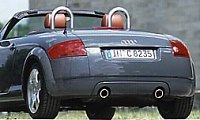 Freeman
Thomas has left the Volkswagen group, but his spirit still lives on the
new TT Roadster. Compare with the Coupe, the Roadster is even more
loyal
to his original design shown in the 1995 concept car. Where the Coupe
has
to revise the rear quarter window to offer better visibility, the
Roadster
has no such problem. A pair of banished roll-over bars is still there.
The electric hood is still exposed when fold down, without any cover.
Otherwise
there are no much difference between the Roadster and the Coupe.
Freeman
Thomas has left the Volkswagen group, but his spirit still lives on the
new TT Roadster. Compare with the Coupe, the Roadster is even more
loyal
to his original design shown in the 1995 concept car. Where the Coupe
has
to revise the rear quarter window to offer better visibility, the
Roadster
has no such problem. A pair of banished roll-over bars is still there.
The electric hood is still exposed when fold down, without any cover.
Otherwise
there are no much difference between the Roadster and the Coupe.
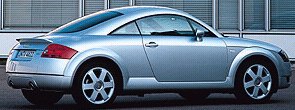 Remember
I criticised Freeman Thomas’ work in Audi TT in June’s Inspiration ? I
wrote "The TT has a drag coefficient of 0.35, the highest of its kind I
heard for more than a decade. For such a high performance car you must
expect a low aerodynamic lift generated, but the TT once again let us
down
with its 418N / 567N front and rear lift measuring at 120mph, versus
Volkswagen
Golf’s 19N / 340N. No wonder German magazine Auto, Motor und Sport
reported
severe high-speed stability problem during a comparison test against
TT’s
close sisters, Audi S3 and VW Golf 4motion."
Remember
I criticised Freeman Thomas’ work in Audi TT in June’s Inspiration ? I
wrote "The TT has a drag coefficient of 0.35, the highest of its kind I
heard for more than a decade. For such a high performance car you must
expect a low aerodynamic lift generated, but the TT once again let us
down
with its 418N / 567N front and rear lift measuring at 120mph, versus
Volkswagen
Golf’s 19N / 340N. No wonder German magazine Auto, Motor und Sport
reported
severe high-speed stability problem during a comparison test against
TT’s
close sisters, Audi S3 and VW Golf 4motion."
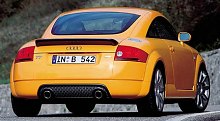 For
4 and a half years, the hottest Audi TT was powered by a 225hp
1.8-litre
four-cylinder turbo engine. That’s fine, but as its platform donor Golf
got a 241hp 3.2-litre V6 in the form of R32, people started questioning
why the Audi coupe still rely on four-pot engines. In just a blink of
eyes,
Audi really adapted the same powerplant to the TT, this became TT 3.2
Quattro.
For
4 and a half years, the hottest Audi TT was powered by a 225hp
1.8-litre
four-cylinder turbo engine. That’s fine, but as its platform donor Golf
got a 241hp 3.2-litre V6 in the form of R32, people started questioning
why the Audi coupe still rely on four-pot engines. In just a blink of
eyes,
Audi really adapted the same powerplant to the TT, this became TT 3.2
Quattro.
 Anyway,
the new V6 is a big improvement from the four-pot, thanks to its smooth
and linear power delivery (from 1500rpm to 6500rpm cut-out) and
instantaneous
throttle response. You know, a small turbocharged four-pot will never
match
a proper normally aspirated V6. The V6 feels far more eager and more
powerful
than the numbers suggest. Admittedly, the addictive engine note
amplifies
that feel.
Anyway,
the new V6 is a big improvement from the four-pot, thanks to its smooth
and linear power delivery (from 1500rpm to 6500rpm cut-out) and
instantaneous
throttle response. You know, a small turbocharged four-pot will never
match
a proper normally aspirated V6. The V6 feels far more eager and more
powerful
than the numbers suggest. Admittedly, the addictive engine note
amplifies
that feel. 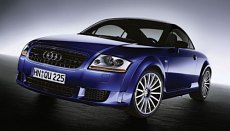 The
TT is 7 years old now and is about to be replaced. Following the
practice of automotive industry, Audi launches a final, special edition
to stimulate sales. This TT Quattro Sport is the hottest ever TT and is
modified by Audi's performance division Quattro GmbH. It is based on
the 225hp 1.8 turbo engine rather than the 3.2 V6. With increased turbo
boost pressure, output is lifted to 240hp and 236lbft. That's still 10
horses less than the V6, but the four-cylinder engine is lighter and in
addition to other weight saving efforts (such as deleted rear seats and
air conditioning), the car undercuts the V6 model by 130 kg. This means
faster acceleration and more agile handling.
The
TT is 7 years old now and is about to be replaced. Following the
practice of automotive industry, Audi launches a final, special edition
to stimulate sales. This TT Quattro Sport is the hottest ever TT and is
modified by Audi's performance division Quattro GmbH. It is based on
the 225hp 1.8 turbo engine rather than the 3.2 V6. With increased turbo
boost pressure, output is lifted to 240hp and 236lbft. That's still 10
horses less than the V6, but the four-cylinder engine is lighter and in
addition to other weight saving efforts (such as deleted rear seats and
air conditioning), the car undercuts the V6 model by 130 kg. This means
faster acceleration and more agile handling.